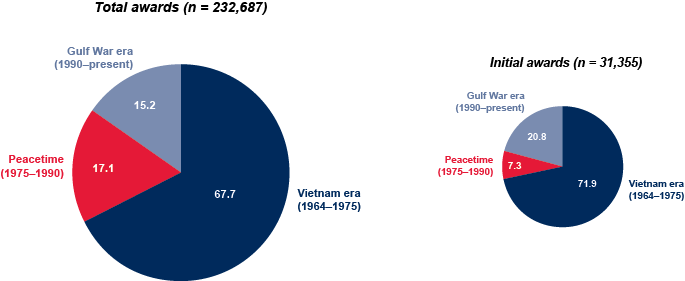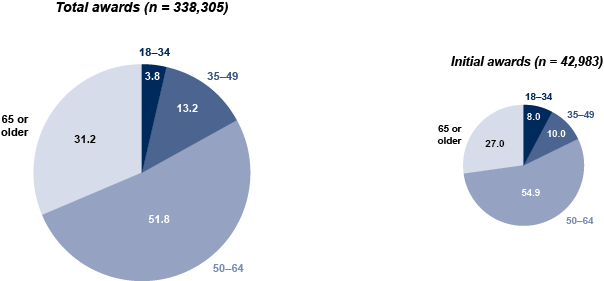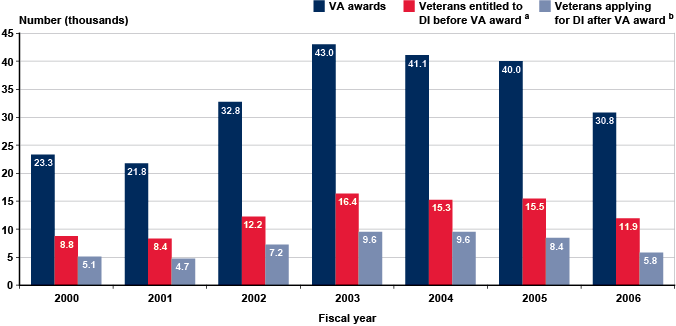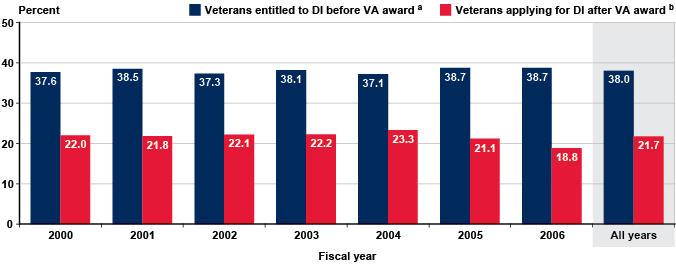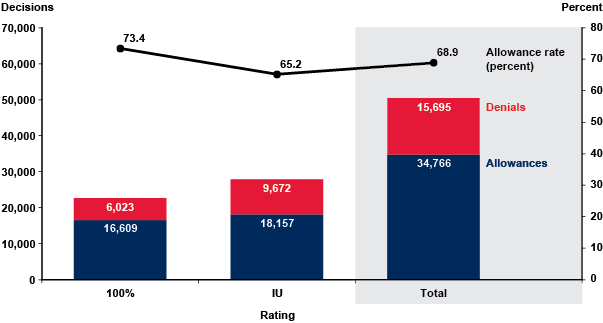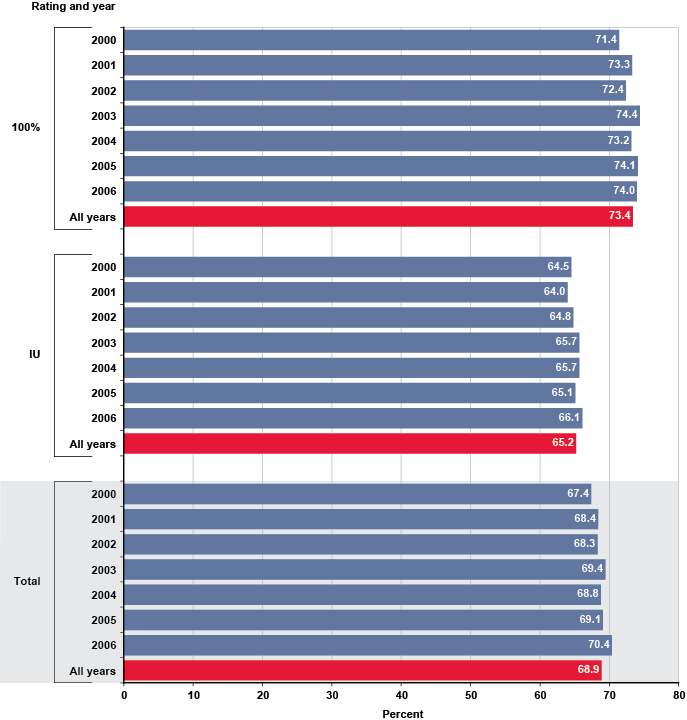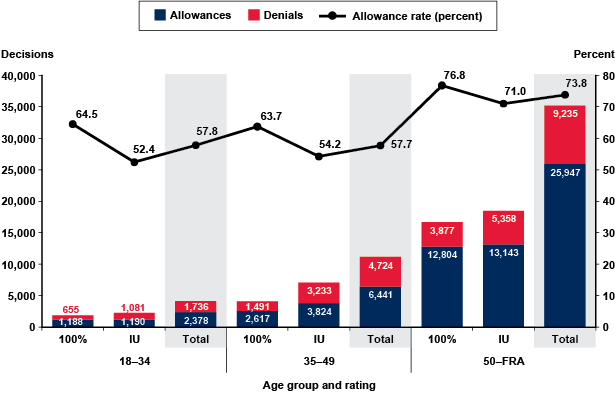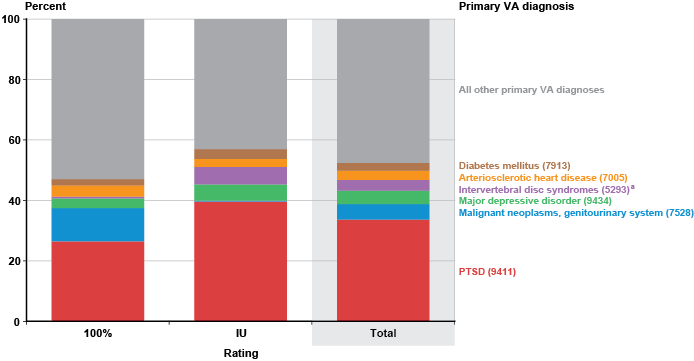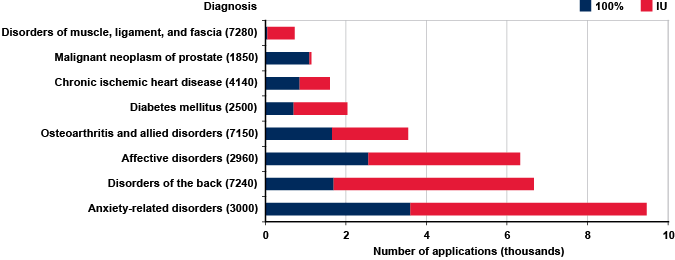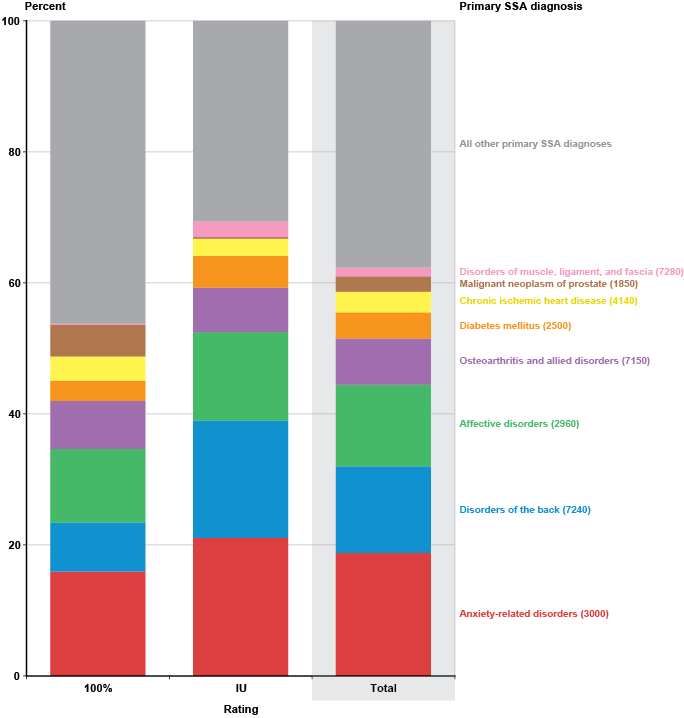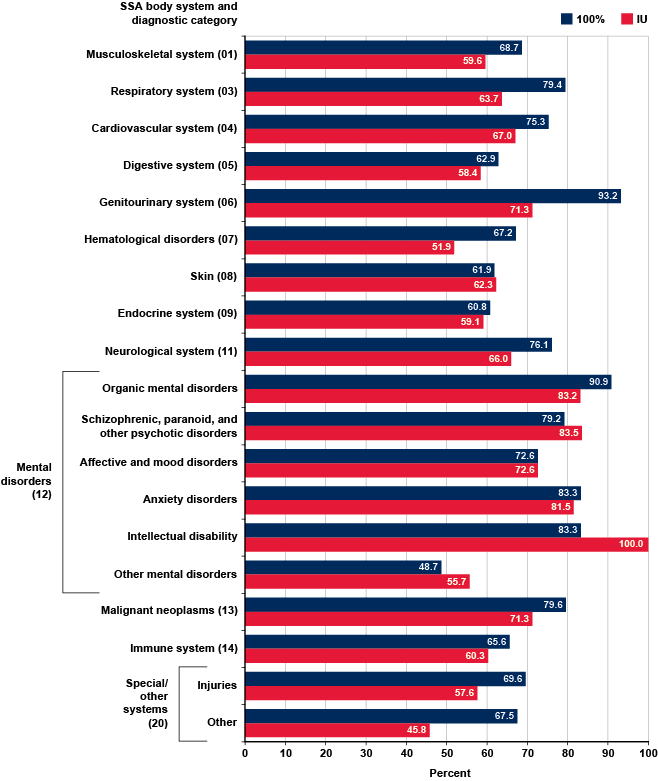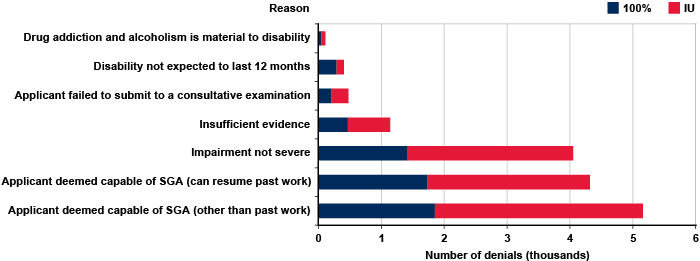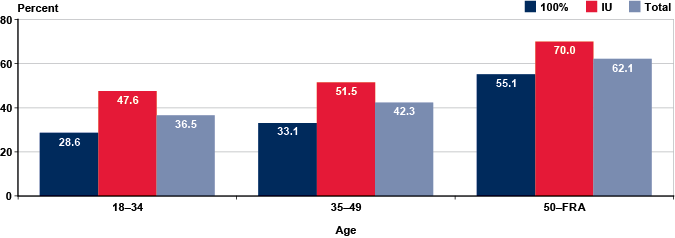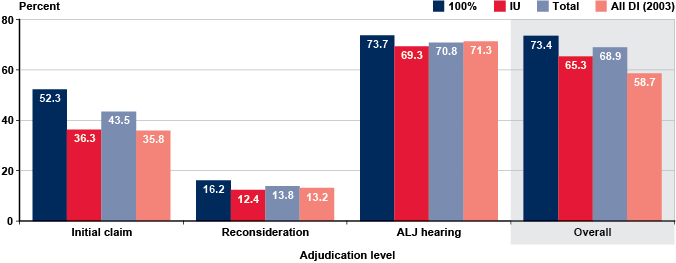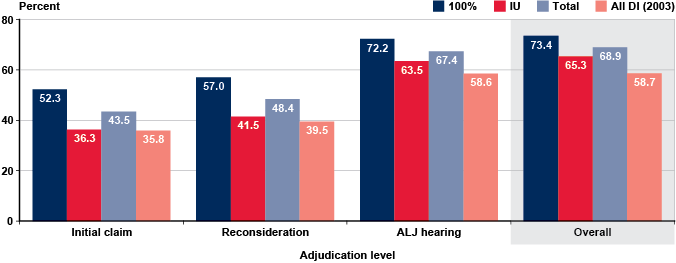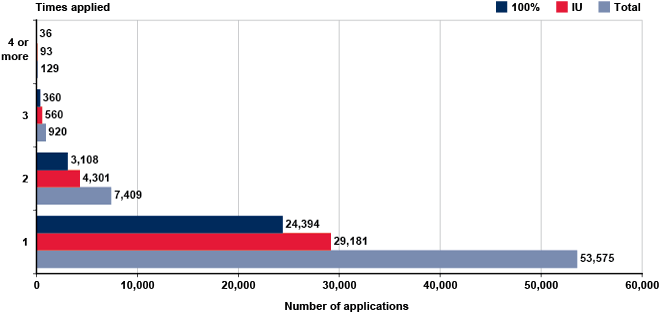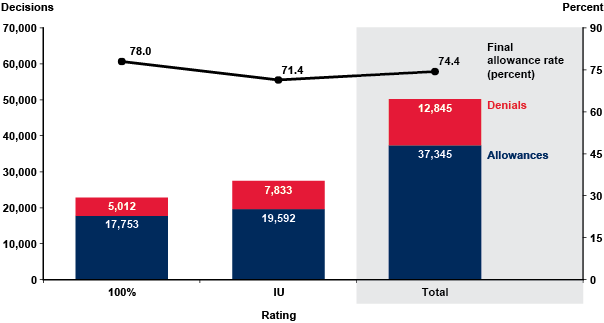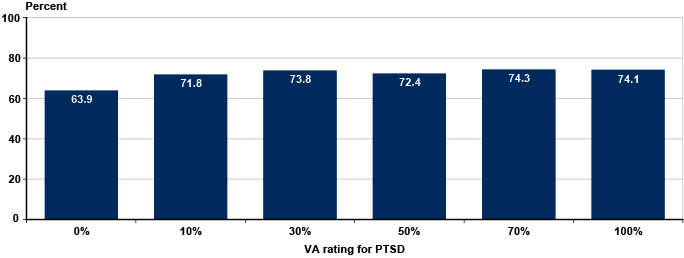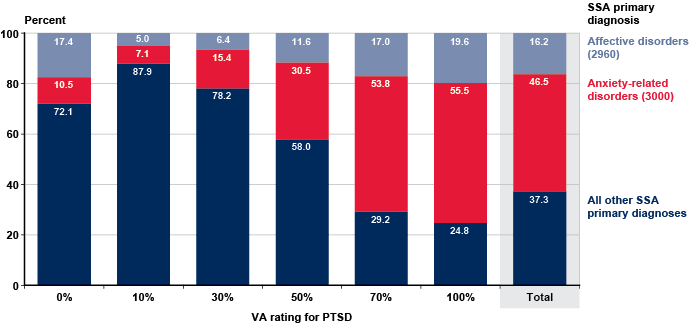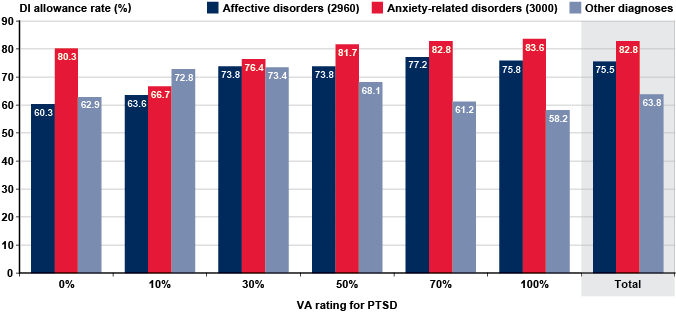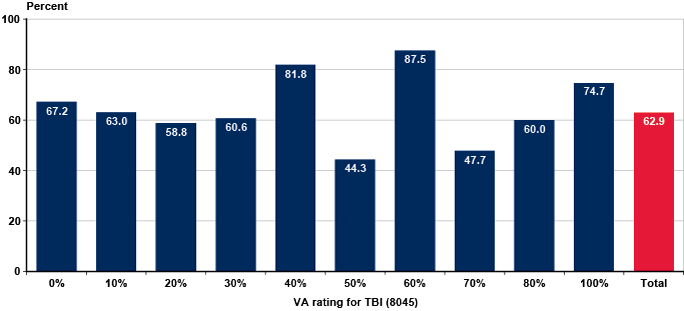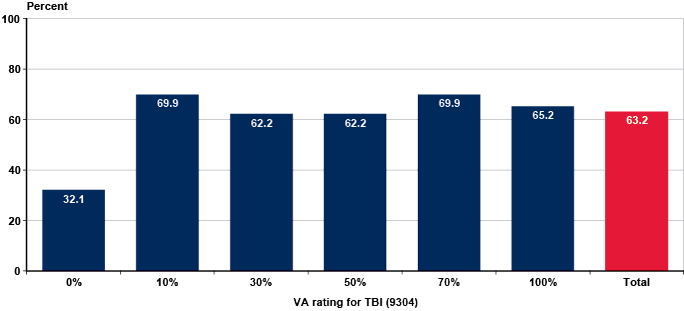Veterans Who Apply for Social Security Disabled-Worker Benefits After Receiving a Department of Veterans Affairs Rating of “Total Disability” for Service-Connected Impairments: Characteristics and Outcomes
Social Security Bulletin, Vol. 74, No. 3, 2014 (released August 2014)
This article examines the interactions between the Department of Veterans Affairs (VA) disability compensation program and the Social Security Disability Insurance (DI) program for veterans rated “totally disabled” by VA. We find that one-half of the veterans rated totally disabled during fiscal years 2000–2006 had already applied for DI benefits and over one-third had received them. Some veterans with VA total-disability ratings did not meet the Social Security Administration's disability standards because of differences in the two programs' purposes and disability criteria. Both programs tend to serve an older population, with more than two-thirds of VA total-disability awards going to Vietnam-era veterans older than age 50. We examine differences in the primary medical diagnoses for veterans with exposure to both programs and pay special attention to the diagnoses of posttraumatic stress disorder and traumatic brain injury.
When this article was written, Scott Muller was an economist with the Office of Research, Evaluation, and Statistics (ORES), Office of Retirement and Disability Policy (ORDP), Social Security Administration (SSA). Nancy Early is a social insurance specialist with ORES, ORDP, SSA. Justin Ronca—formerly with ORES, ORDP, SSA—is the Director of Global People Analytics for Walmart, Inc.
Acknowledgments: For their assistance with the research or review of this article, we acknowledge the contributions of Dat Tran, Joe Salvatore, and anonymous reviewers from the VA; and of Dean Dwight, Stephanie Walter, Art Spencer, and Bert Kestenbaum of SSA.
Contents of this publication are not copyrighted; any items may be reprinted, but citation of the Social Security Bulletin as the source is requested. The findings and conclusions presented in the Bulletin are those of the authors and do not necessarily represent the views of the Social Security Administration.
Introduction
| ALJ | administrative law judge |
| DDS | disability determination service |
| DI | Disability Insurance |
| FRA | full retirement age |
| IU | individual unemployability |
| MC/WW | military casualty/wounded warrior |
| PTSD | posttraumatic stress disorder |
| SGA | substantial gainful activity |
| SGE | substantially gainful employment |
| SSA | Social Security Administration |
| SSI | Supplemental Security Income |
| VA | Department of Veterans Affairs |
In recent years, policymakers have examined the interaction of two federal programs that provide benefits to military personnel with service-connected disabilities. In September 2009, the Government Accountability Office issued a report recommending that the Social Security Administration (SSA) increase its outreach and collaboration with the Department of Veterans Affairs (VA) to improve access to Social Security disability benefits for military personnel wounded since October 2001 in operations in Afghanistan and Iraq (GAO 2009). Also in 2009, both houses of Congress introduced legislation known as the BRAVE Act1 that would certify veterans judged by the VA to have total disability (that is, having a combined rating of 100%2 or a rating of individual unemployability [IU]) as meeting the medical requirements of the disability programs administered by SSA. Essentially, a veteran with a rating of total disability would not have to undergo the medical portions of SSA's disability determination to be eligible to receive Social Security disability benefits. The veteran would have to be insured for disability in order to qualify for Disability Insurance (DI) worker benefits and could not be engaged in substantial gainful activity (SGA).
With a focus on DI, the research reported herein is part of SSA's work toward increasing coordination between the VA disability compensation program and SSA's disability programs. It is important to understand that DI and the VA disability program serve different purposes, have different definitions of disability, and may not integrate well. This article highlights the intent and provisions of each program, and then presents data on the historical interactions between them using matched administrative records from the two programs. It also examines the probable outcomes had the BRAVE Act been enacted.
VA Disability Compensation
The VA disability compensation program pays benefits to veterans who incur an injury or contract a disease that is service-connected—that is, the result of disability incurred in, presumptively related to, or aggravated by their military service. VA evaluates and rates each service-connected disability (injury or disease) with a percentage value from 0 to 100 according to a schedule established by regulation.3 For veterans with more than one disabling condition, VA combines the individual ratings into a single combined rating and rounds it to the nearest 10%. Disabled veterans with a combined rating of 10% or greater are entitled to compensation in the form of a cash benefit. A single- or combined-impairment rating of 100% constitutes total-disability status. As the accompanying tabulation shows, higher disability ratings entitle recipients to greater benefit amounts.
| VA disability rating | 2014 monthly compensation level ($) |
|---|---|
| 10% | 131 |
| 20% | 259 |
| 30% | 401 |
| 40% | 578 |
| 50% | 822 |
| 60% | 1,041 |
| 70% | 1,312 |
| 80% | 1,526 |
| 90% | 1,714 |
| 100% | 2,858 |
| SOURCE: VA (2013). | |
Cash benefits are intended to compensate for the average wage loss for someone with a specific impairment, although benefits are paid regardless of whether the impairment actually causes earnings losses for the individual. Additional cash benefits may be paid to dependents (spouse and children). Special monthly compensation may be paid for disabilities creating a need for regular aid and attendance or rendering the veteran bedridden or housebound, or disabilities requiring adapted housing or grants for housing modifications and/or automobile or adaptive vehicle modifications. Special monthly compensation can also be paid for amputations and loss of use of extremities and other specific combinations of disabilities.
Generally, veterans who receive disability compensation cash benefits are free to work and are not limited in the amount of earnings they may receive, even when their single- or combined-impairment ratings are 100%. The one exception is for those veterans who are determined to be totally disabled because of IU. Generally, those individuals must have a combined rating of 60% or greater for a single impairment or, in the case of multiple impairments, a combined rating of 70% or greater (with at least one impairment rated 40% or higher), and they must be determined to be unemployable because of their service-connected disabilities. A determination of unemployability is based on the veteran's service-connected disabilities, disability rating, and certain factors that affect the ability to perform “substantially gainful employment” (SGE).4 Those factors include work history, reason for termination, attempts at vocational rehabilitation services, and other factors that affect his or her ability to work.5
The IU rating entitles veterans to the same compensation level as a 100% rating. However, IU-rated veterans must report their earnings every 12 months.6 After a veteran has had earnings for a period of 12 months, VA will review his or her IU rating. If the investigation shows that their earnings exceed the established earnings amount for SGE for 12 months, VA reevaluates the IU rating, which could result in the loss of total-disability status. If earnings are not found to be substantially gainful for 12 months, entitlement to the IU rating continues.
The VA disability rating is not necessarily permanent. If impairments worsen, a disabled veteran can request an increase in the disability rating. If maintaining significant employment becomes difficult, the veteran can seek IU status, which would increase the benefit level to that of a 100% rating. If impairments improve, VA may reduce the disability rating.
Initial disability determinations are made in VA regional offices. First-level appeals are also handled within the regional offices, where there is the potential for a de novo review and a hearing in front of another decision maker. At the second level, cases go before the Board of Veterans Appeals, where Veterans Law Judges (VLJs) provide a de novo review; claimants have the opportunity to appear in person or by videoconference. The Board's decision may be appealed to the U.S. Court of Appeals for Veterans Claims, an independent court that is not part of the VA. Further appeals may be filed with the U.S. Court of Appeals for the Federal Circuit and finally with the U.S. Supreme Court.7
Social Security Disability
SSA administers programs under Titles II and XVI of the Social Security Act: respectively, the Old-Age, Survivors, and Disability Insurance (OASDI) program and the Supplemental Security Income (SSI) program for the aged, blind, and disabled. The financing of the two programs differs fundamentally. Social Security disability benefits are funded through payroll contributions made by wage earners to the OASI and DI Trust Funds. SSI payments, funded through general taxes, are means-tested and support recipients with little or no work experience. The disability criteria used to adjudicate disability claims are also used in adult SSI disability determinations.
Social Security disability beneficiaries consist of disabled workers, disabled widow(er)s, and disabled adult children. Disabled-worker benefits are paid from the DI Trust Fund; disabled widow(er) benefits are paid from the Old Age and Survivors Insurance Trust Fund; and disabled adult children benefits can be paid from either trust fund, depending on the benefit status of the primary beneficiary. To be eligible for disabled-worker benefits, an individual must be insured for disability, which is based on the number of quarters of coverage the individual has earned in covered work and the recency of that work.8 Disabled widow(er) and disabled adult children benefits are based on the earnings record of the worker on whom they were, or are, dependent.
A disabled veteran could theoretically qualify for DI benefits in any of those beneficiary categories, but because military service is covered employment, the veteran would most likely qualify as a disabled worker and receive benefits on his or her own earnings record. Likewise, a veteran could meet SSI's disability criteria, but the VA benefit payments for veterans rated 100% or IU exceed the SSI means test. For these reasons, this article focuses on the DI disabled-worker benefit.
To meet SSA's definition of disability, an individual must be unable to perform SGA because of an impairment that has lasted or can be expected to last 12 months or end in death. The SGA concept performs essentially the same function as SGE and, not surprisingly, uses a roughly equivalent earnings threshold: In 2011, VA defined SGE as $11,484 per year, and SSA defined SGA as $1,000 per month ($12,000 per year).
To apply for DI benefits, an individual files the disability claim online, via phone or mail, or in an SSA field office. A disability examiner makes the initial determination with the support of medical or psychological consultants, or both, in a state-run disability determination service (DDS). The DDS follows the 5-step sequential evaluation process shown in Box 1.
SSA disability determination: The five-step sequential evaluation process
| Step | Procedure |
|---|---|
| 1 | Is the individual engaged in SGA? If yes, deny. If no, continue to step 2. |
| 2 | Is there a medically determinable impairment (or combination of impairments) and is the impairment severe and expected to last 12 months or end in death? If no, deny. If yes, continue to step 3. |
| 3 | Does the impairment meet, or equal in severity, a medical listing? a If yes, allow. If no, continue to step 4. |
| Medical-vocational considerations b | |
| 4 | Can the individual do his/her past work? If yes, deny. If no, continue to step 5. |
| 5 | Can the individual do any other work? If yes, deny. If no, allow. |
| SOURCE: Adapted from SSA (n.d. b). | |
| a. SSA's listing of impairments “describes, for each major body system, impairments considered severe enough to prevent an individual from doing any gainful activity” (SSA n.d. a). | |
| b. These decisions involve comparing the individual's residual functional capacity to the requirements of the work and, at step 5, considering the impact of vocational factors such as age, education, and skills on the ability to adjust to other work. | |
A claimant may request reconsideration of an unfavorable determination, in which case a different DDS examiner reviews the claim. The next level of appeal is a hearing in the Office of Disability Adjudication and Review with an administrative law judge (ALJ), a federal employee who works for SSA.9 The hearing provides the claimant's first opportunity to appear before an adjudicator, either in person or by videoconference. Further appeals may be filed with the SSA Appeals Council, and then with the U.S. court system.
The DI benefit is intended to replace a portion of lost earnings and is paid only for a total disability; that is, unlike the VA program, DI does not account for levels of disability. The amount of the DI benefit is based on the individual's average indexed monthly earnings rather than on a benefit schedule, as in the VA program. The average monthly disabled-worker DI benefit was $1,068 in December 2010, but an individual's benefit could be much higher, depending on past earnings. Some dependents of disabled workers may also qualify for DI benefits, to a maximum of 50 percent of the worker's benefit. DI beneficiaries can earn up to the SGA level without losing benefits. However, the program also provides work incentives that encourage beneficiaries to return to work and to ease the transition back to self-support. Examples of those incentives follow:
- A trial work period of 9 months (not necessarily consecutive), in which the individual can have any level of earnings without affecting eligibility for DI benefits.
- An extended period of eligibility, during which benefits are paid in full if earnings fall below the SGA level.
- An “easy back on” provision that permits a return to the DI rolls if the individual's original impairment results in an inability to continue working.
Coordination Between VA and SSA
VA and SSA are required by law to share the following types of information:10
- Medical evidence and hospital records.
- Disability determinations.
- Benefit receipt and payment amounts.
In processing a DI claim, a DDS requests the medical evidence it deems necessary from service providers. A DDS may request records from a VA regional office or a VA hospital. In 2010, SSA made an estimated 154,000 medical record requests to VA for over 100,000 claimants.
In turn, VA directs its medical-evidence requests to SSA at one of two centralized locations: the National Records Center, for information on claimants older than age 55; and the Operations Megacenter, for records of those aged 55 or younger. VA generally requests records by fax, but SSA has tested and is rolling out a process by which medical evidence is requested by and returned to VA through the Government Secure Online Messaging System.
Generally, both SSA and VA are required to consider the other agency's disability decision in making their own determinations, although neither agency's decision is binding on the other.11
SSA provides Social Security number verification, Social Security and SSI benefit status, and limited payment histories to the VA via its Federal Online Query system. VA provides beneficiary data to SSA through a data exchange agreement. SSA and VA use the benefit receipt and payment data as income verification for their respective means-tested programs (SSI and VA pensions).
SSA also identifies and expedites disability claims for individuals who qualify as military casualty/wounded warrior (MC/WW) cases. The MC/WW policy addresses service members who incurred an injury, illness, or wound (regardless of how or where it occurred) while on active duty on or after October 1, 2001. SSA identifies MC/WW cases using a weekly list of wounded warriors sent by the Department of Defense and by asking questions about military service in a claimant's disability interview (SSA 2012). Additionally, in March 2014, SSA initiated an expedited disability claim process for veterans with a VA disability rating of 100% permanent and total. However, that rating does not guarantee qualification for Social Security disability benefits; the veteran must still meet all SSA medical and technical eligibility criteria for disability benefits.
SSA and VA are working together to increase program coordination and to expedite decisions wherever possible. Different program purposes, definitions of disability, and disability criteria limit the extent to which coordination is possible. This article will show that having SSA adopt VA decisions of total disability, as proposed in the BRAVE Act, could result in medical allowances for individuals who would not otherwise meet the SSA standard and thereby substantially increase DI program costs.
The Data
SSA established a data linkage agreement with the VA in order to conduct this research. SSA received a VA data file for all service-connected disability compensation awards with a rating of either 100% (single-impairment or combined) or IU made during fiscal years 2000–2008. Because of limitations in the data for the later years, this research uses data for fiscal years 2000–2006 only.12 The VA data included information about the disability rating, the impairments that were rated, and the date of award. All records reflected new awards of 100% or IU benefits, although many awardees were on the VA rolls in earlier years at lower ratings and their “new awards” represented a rating increase to the 100% or IU level.
SSA then matched those data with its own administrative records to develop a history of VA disability compensation and DI program interactions.13 VA data were matched to SSA records in the Numerical Identification (Numident) file, to obtain dates of birth and death; in the Master Beneficiary Record, to obtain information on DI applications and benefit receipt; and in the Disability Research File, to obtain specifics about the disability decision, including SSA's diagnosis. The veterans we studied—those who received ratings of 100% or IU during fiscal years 2000–2006—may (or may not) have applied for DI at any time before or after their VA award, from DI program inception in 1956 until as recently as calendar year 2010, the latest year for which matching administrative records were available.
We excluded veterans aged 65 or older at the time of their VA award, as those individuals would generally not be eligible for DI benefits.14 Nearly one-third of the VA total-disability awards during fiscal years 2000–2006 were to veterans aged 65 or older.
SSA and VA use different impairment classification systems. SSA uses approximately 170 impairment codes, which are derived from the International Classification of Diseases, Ninth Revision (ICD-9) coding system. SSA records indicate the primary impairment and, in some cases, a secondary impairment. The VA system has several thousand impairment codes, each of which can be included in developing the final composite rating for an individual. VA may rate an individual for any number of conditions, but the records provided to SSA were limited to six impairments. Comparing impairments across the programs was therefore imprecise and somewhat difficult.
Characteristics of VA Awards for Veterans Rated 100% or IU
Before we delved into the data, we expected to find that MC/WW service members—that is, those serving in the Afghanistan and Iraq conflicts—would dominate the count of VA disability compensation awards with 100% and IU ratings. However, the analysis revealed something quite different: More than two-thirds of the individuals awarded compensation based on VA ratings of 100% or IU during fiscal years 2000–2006 were Vietnam-era veterans (Chart 1). Veterans who served during the Gulf War era, which VA defines as including not only the Afghanistan and Iraq conflicts but also the 1990 Gulf War and the intervening period, accounted for only about one in seven awards.15 Only 13 percent of awards based on ratings of 100% or IU represented the veteran's first VA benefit award. Within that group, Vietnam-era veterans constituted 72 percent of the awards and Gulf War-era veterans represented 21 percent. Progressive conditions and policy changes acknowledging the health effects of exposure to the herbicide Agent Orange likely contributed to the large share of initial VA awards for Vietnam-era veterans.
Percentage distribution of veterans aged 18–64 awarded VA disability compensation on the basis of disability ratings of 100% or IU during fiscal years 2000–2006, by period of service
As one might expect, the predominance of Vietnam-era veterans among the awardees is reflected in the concentration of awards in older age groups (Chart 2). Claimants aged 50–64 represented 52 percent of awards based on ratings of 100% or IU. Less than 4 percent of awards based on those ratings went to individuals aged 18–34.
Percentage distribution of veterans awarded VA disability compensation on the basis of disability ratings of 100% or IU during fiscal years 2000–2006, by age at VA award
The age-group distribution of initial awards based on 100% or IU ratings generally resembles that for all such awards. We note, however, that the share of initial awards garnered by those aged 18–34 doubles their proportion of all awards (8 percent versus 4 percent).
Timing of DI Application and Entitlement
Chart 3 shows that nearly three-quarters (73 percent) of the disabled veterans awarded a VA rating of 100% or IU also applied for DI benefits at some point. Within that group, about 70 percent had already filed their first DI application before they received their VA award, and the remaining 30 percent filed after they received their award. For 27 percent of the disabled veterans in our sample, we did not find evidence of filing DI benefit claims.
Percentage distributions of veterans who received a VA disability compensation award based on ratings of 100% or IU during fiscal years 2000–2006, by timing of first DI application and entitlement to DI benefits
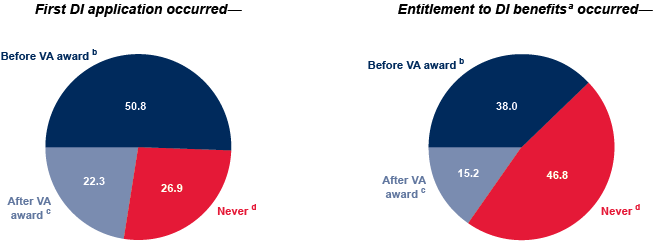
SSA records further show that 38 percent of the disabled veterans were already on the DI rolls when they received their 100% or IU ratings. It was not possible to determine whether, or to what extent, SSA's allowance of a DI application may have affected the subsequent VA rating.
Chart 4 shows, for each study year, the number of VA awards based on ratings of 100% or IU, the number of veterans who were entitled to DI benefits before their VA awards, and the number who filed DI applications after their VA awards. Relative to fiscal year 2000, the first year of the study, VA awards nearly doubled at their study-period peak in fiscal year 2003, then declined thereafter. Part of the spike may reflect new regulations that took effect in July 2001. Those regulations added type 2 diabetes to the list of impairments presumed to be service-connected and caused by exposure to Agent Orange. The number of veterans applying for DI after receiving a VA award of 100% or IU during the study period peaked in fiscal year 2004.
Number of veterans awarded VA disability compensation on the basis of disability ratings of 100% or IU during fiscal years 2000–2006, number entitled to DI benefits before the VA award, and number applying for DI benefits after the VA award, by fiscal-year VA-award cohort
Chart 5 shows that the percentage of VA awardees who were entitled to DI before receiving their 100% or IU rating was relatively constant at 37 to 39 percent for each fiscal-year cohort of awards. The percentage of veterans that applied for DI after receiving a VA award declined from 23 percent in fiscal year 2004 to 19 percent in fiscal year 2006. That outcome likely reflects the shorter period during which the latter award cohorts could apply for DI. As time passes, the DI application rate for latter cohorts will likely increase.
Percentage of veterans awarded VA disability compensation on the basis of disability ratings of 100% or IU during fiscal years 2000–2006, percentage entitled to DI benefits before the VA award, and percentage applying for DI benefits after the VA award, by fiscal-year VA-award cohort
First DI Application After Receiving a VA Rating of 100% or IU
Some disabled veterans who apply for DI benefits and are denied will reapply, in some cases more than once. In this section, we focus on the first DI applications filed by veterans after receiving a VA rating of 100% or IU.
During fiscal years 2000–2006, disabled veterans with VA ratings of 100% or IU filed 50,461 postaward first applications for DI that resulted in a medical decision (either allowance or denial). An additional 6,559 cases resulted in technical denials, generally because the applicant lacked sufficient prior earnings to be insured for disability. We exclude technical denials from this analysis and from the calculation of the allowance rates.16
Chart 6 shows the number of postaward first DI applications and their medical decision outcomes, with detail for the 100% and IU ratings. IU-rated veterans accounted for 55 percent of the applications filed by totally disabled veterans (27,829 of 50,461). The DI allowance rate for applicants with an IU rating (65 percent) was lower than the allowance rate for applicants rated 100% (73 percent). Chart 7 shows that the postaward first DI application allowance rates for veterans with VA ratings of 100% and IU were stable across the VA-award cohorts from fiscal year 2000 through fiscal year 2006.
Medical decisions and allowance rates for first DI applications filed by veterans after receiving VA disability ratings of 100% or IU during fiscal years 2000–2006, total and by rating
Allowance rates for medical decisions for first DI applications filed by veterans after receiving VA disability ratings of 100% or IU during fiscal years 2000–2006, by VA rating and fiscal-year VA-award cohort (in percent)
Applicants by Age Group
Chart 8 shows the number of DI allowances and denials and the associated allowance rates by age group and VA rating. Veterans aged 50 to full retirement age (FRA)17 filed more than two-thirds of the DI applications filed by all age groups.
Medical decisions and allowance rates for first DI applications filed by veterans after receiving VA disability ratings of 100% or IU during fiscal years 2000–2006, by age group and VA rating
In each age group, the allowance rate for cases with a 100% rating was higher than the allowance rate for IU cases. Additionally, allowance rates for those aged 50–FRA were considerably higher (15 percentage points) than the rates for those in the two younger age groups. The age-group difference is likely a function of the role that age plays in DI decisions involving medical-vocational considerations (see Box 1). Within each VA rating category, the two younger age groups had similar allowance rates (Chart 8). However, within each age group, the difference in allowance rates between the IU and 100% ratings is substantially greater for the younger groups: 12.1 percentage points for ages 18–34, 9.5 percentage points for ages 35–49, and 5.8 percentage points for ages 50–FRA.
Diagnoses of Applicants
Veterans who apply for DI benefits after receiving a VA rating of 100% or IU are diagnosed independently by each agency. Thus, their records contain two primary diagnoses: one from VA and one from SSA. The VA's primary diagnosis reflects the impairment to which VA assigns the highest rating. The SSA primary diagnosis generally reflects the condition that either renders the individual disabled or has the most significant effect on his or her ability to work, as identified by the decision maker. Furthermore, the two agencies define certain diagnoses differently; for example, unlike VA, SSA has no separate diagnosis of posttraumatic stress disorder (PTSD), instead using more broadly defined categories such as anxiety-related disorders. As such, in comparing the primary diagnoses identified by the VA and SSA, we find some significant differences.
Chart 9 shows the frequency of the six most common primary VA diagnoses for totally disabled veterans applying for DI benefits, and Chart 10 reveals that those six diagnoses accounted for about half of the DI applicants. PTSD, by far the most common primary diagnosis, accounted for about one-quarter of applicants with a VA rating of 100% and nearly 40 percent of applicants rated IU. Notably, several of the other major diagnoses tended to be age-related conditions, such as malignancies of the genitourinary system, arteriosclerosis, and diabetes.
Number of first DI applications filed by veterans after receiving VA disability ratings of 100% or IU during fiscal years 2000–2006, by most frequent primary VA diagnoses and VA rating
Percentage distribution of first DI applications filed by veterans after receiving VA disability ratings of 100% or IU during fiscal years 2000–2006 by primary VA diagnosis, by VA rating
Chart 11 shows the frequency of the eight most common primary SSA diagnoses for our study sample, of which anxiety-related disorders occurred most often. As with the VA diagnoses, many of the SSA primary impairments are diseases and conditions often associated with age: disorders of the back, osteoarthritis, diabetes, chronic ischemic heart disease, and prostate cancer. Chart 12 shows that the eight leading SSA primary diagnoses accounted for about 54 percent of applicants with a 100% VA rating, nearly 70 percent of those rated IU, and about 62 percent of the applicants overall. Affective disorders was the third-most frequent SSA primary diagnosis; combined with anxiety-related disorders, the two diagnoses made up 27 percent of the applicants with a VA rating of 100% and about 35 percent of those rated IU. The applicants who were diagnosed by SSA with those two mental disorders represented about the same proportion of cases as those diagnosed by the VA with PTSD. SSA identified back disorders as the primary impairment much more frequently (13 percent) than did VA (less than 4 percent), and identified them much more frequently among the veterans rated IU (18 percent) than among veterans with a rating of 100% (8 percent).
Number of first DI applications filed by veterans after receiving VA disability ratings of 100% or IU during fiscal years 2000–2006, by most frequent primary SSA diagnoses and VA rating
Percentage distribution of first DI applications filed by veterans after receiving VA disability ratings of 100% or IU during fiscal years 2000–2006 by primary SSA diagnosis, by VA rating
Chart 13 shows DI allowance rates for applicants by the body system of the primary SSA diagnosis, with detail for selected mental impairments. For all but a few of the body systems, the allowance rate for veterans with a VA rating of 100% was greater than the allowance rate for those with an IU rating.
Allowance rates for first DI applications filed by veterans after receiving VA disability ratings of 100% or IU during fiscal years 2000–2006, by VA rating and SSA primary diagnosis body system and selected diagnostic categories
Reasons for DI Allowances and Denials
Chart 14 shows medical denials of postaward first DI applications for veterans receiving a VA rating of 100% or IU, by reason. We again exclude 6,559 technical denials, or cases denied for nonmedical reasons (such as not being insured for disability) from our sample. The greatest number of medical denials were for applicants deemed capable of work other than their previous work (the fifth step of the five-step sequential evaluation process for determining disability shown in Box 1), followed by step-4 denials (indicating the capacity to do past work) and step-2 denials (based on a finding of nonsevere impairment).18 Over one-quarter of the DI denials involved impairments that SSA judged to be nonsevere in cases that VA rated 100% or IU. Among those rated IU—indicating that VA found the individual unable to engage in SGE—27 percent of those denied DI benefits were found by SSA to have a nonsevere impairment. Furthermore, over 60 percent of the veterans rated IU by VA and denied by SSA were judged to be capable of SGA, providing one measure of the extent to which the two programs' evaluation criteria indicate their different purposes.
Medical denials for first DI applications filed by veterans after receiving VA disability ratings of 100% or IU during fiscal years 2000–2006, by VA rating and SSA reason for denial
Chart 15 shows the percentages of DI claims allowed based on medical-vocational considerations, grouped by age at DI entitlement.19 Medical-vocational considerations are those that result in allowances at step 5 of the sequential evaluation process for determining disability, respectively involving the ability to resume past work or to engage in other work considering the claimant's age, education, and prior work experience (Box 1). The remaining allowances are attributable to claimants with impairments meeting or equaling a medical listing (step 3 in the process). Chart 15 shows that the medical-vocational share of allowances increases with age, as might be expected as SSA applies vocational “grids” to determine if the individual has the ability to do other work. The grids take into account the claimant's age and provide lower thresholds for allowing a claim at older ages. Individuals of all ages with a VA rating of IU are more likely to receive a medical-vocational allowance than are veterans with a 100% rating.
Allowances on the basis of medical-vocational considerations as a percentage of all allowances: First DI claims filed by veterans after receiving VA disability ratings of 100% or IU during fiscal years 2000–2006, by VA rating and age group at date of entitlement to DI
Allowance Rates by Level of Adjudication
SSA has several levels of adjudication: the initial DDS determination and three levels of appeal. The successive levels for appeals are reconsideration, ALJ hearing, and the Appeals Council.20 After exhausting SSA appeals, cases can be taken to the federal courts. This section examines allowance rates at each level and compares the results with those for disabled-worker DI applicants from the general population in calendar year 2003.
Chart 16 shows that at each of the first three levels of adjudication, as well as overall, veterans with a 100% VA rating had higher allowance rates than did those with an IU rating. Totally disabled veterans overall had higher allowance rates than DI applicants from the general population at the initial level, but they had similar allowance rates at the reconsideration and hearings levels.
Allowance rates for first DI claims filed by veterans after receiving VA disability ratings of 100% or IU during fiscal years 2000–2006, by VA rating and level of adjudication (with comparisons to allowance rate for all DI worker claims filed in calendar year 2003)
Of the 34,766 postaward first DI claims of totally disabled veterans that were ultimately allowed, nearly two-thirds of allowances came at the initial level and over one-quarter came in ALJ hearings. The proportion of allowances coming from appeals is lower for these disabled veterans than for the general disabled-worker applicant population (not shown).
Taken cumulatively, veterans with 100% VA ratings had the highest allowance rates, and the rates for totally disabled veterans overall were somewhat higher than those for DI applicants in the general population (Chart 17). After all SSA appeals, cumulative allowance rates were 73 percent for veterans with VA ratings of 100%, 65 percent for veterans rated IU, and 59 percent for DI disabled-worker applicants overall.21
Cumulative allowance rates for first DI claims by veterans after receiving VA disability ratings of 100% or IU during fiscal years 2000–2006, by VA rating and level of adjudication (with comparisons to allowance rate for all DI worker claims filed in calendar year 2003)
Multiple Applications for DI and Final Decision Outcomes
Thus far, we have analyzed veterans' first applications for DI disabled-worker benefits after receiving the VA rating of 100% or IU. DI applicants who are denied benefits may reapply, generally after exhausting all appeals. To determine the final allowance rate for this population of disabled veterans, we also considered decisions on all subsequent applications.
Chart 18 shows the number of totally disabled veterans who applied for DI by the number of times they applied after receiving the VA award of total disability. We include the 6,559 applicants with technical denials of their first applications because those individuals are eligible to reapply. Nearly 8,500 disabled veterans applied more than once, and individuals applied as many as seven times.
Veterans who applied for DI after receiving VA disability ratings of 100% or IU during fiscal years
2000–2006, by VA rating and number of times applied for DI as of mid-2010
Chart 19 shows the medical decision on the most recent DI application filed by veterans after receiving their 100% or IU rating from the VA; that is, it provides the final allowance rate for those veterans as of 2010, the time of data extraction. The final allowance rate for veterans with a 100% rating was 78 percent, compared with 73 percent for those with a medical decision on their first application (see Chart 6); those rated IU had a final allowance rate of 71 percent, compared with 65 percent for those with a medical decision on their first application.
Medical decisions for last DI applications filed by veterans after receiving VA disability ratings of 100% or IU during fiscal years 2000–2006, and final DI allowance rate, by VA rating, as of mid-2010
Diagnoses of Special Interest
Two diagnoses for veterans are of special interest to SSA, the VA, and policymakers: PTSD and traumatic brain injury (TBI). Both diagnoses have been associated with veterans returning from Iraq and Afghanistan. In this section, we focus on DI applicants with VA ratings for PTSD (code 9411), residuals of TBI (code 8045), and dementia associated with TBI (code 9304).22
As we have demonstrated, veterans with VA ratings of 100% or IU who apply for DI benefits tend to be in older age groups. The same is true of veterans diagnosed with PTSD or TBI. Chart 20 shows the age distribution of DI applicants rated for PTSD or TBI at any level from 10% to 100%. The largest proportions of VA awardees applying for DI benefits were in the oldest age group of DI applicants (50–FRA). The vast majority of DI applicants with a VA rating for PTSD (86 percent) filed after reaching age 50; those individuals are likely to be Vietnam veterans. There are few DI applicants among younger veterans with PTSD ratings. Younger veterans were more widely represented among DI applicants with TBI than they were among those with PTSD; nevertheless, the oldest age group still constituted the largest proportion of DI applicants with TBI. It appears that the disabling impact of PTSD and TBI emerges at older ages, rather than at the time of separation from service.
First DI applications filed by veterans after receiving disability ratings of 100% or IU during fiscal years 2000–2006: Percentage distribution by age group, for PTSD and TBI diagnoses
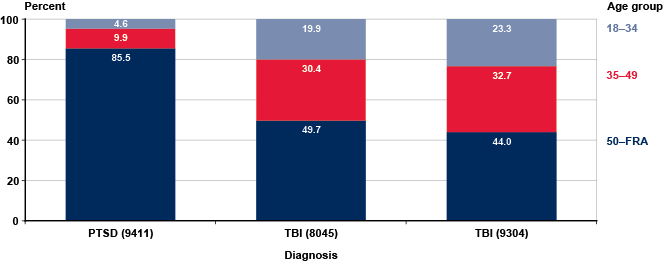
PTSD
For our sample of disabled veterans applying for DI benefits, Chart 9 showed that the predominant primary VA diagnosis—that is, the highest-rated diagnosis—was PTSD, accounting for over 17,000 DI applicants, or one-third of those applying for DI after their VA award. However, veterans in the sample for whom the VA diagnosed PTSD at any rating level numbered 20,804, or over 40 percent of those applying for DI. Because certain VA rules affecting PTSD assessments have changed in recent years, the prevalence of PTSD diagnoses has likely increased since the period covered in this research. Chart 21 shows that, except for those with a rating of 0% (64 percent allowance rate), the DI allowance rates did not vary much between VA ratings for PTSD (from 72 to 74 percent).23
Allowance rates for first DI applications filed by veterans after receiving VA disability ratings of 100% or IU during fiscal years 2000–2006, by VA rating for PTSD
Chart 22 shows, for each of six rating levels for PTSD, the distribution of DI allowances by primary SSA diagnosis. Anxiety-related disorders represented a larger proportion of favorable decisions than affective disorders for all VA ratings of PTSD except 0%. Overall, nearly two-thirds of allowed DI claims filed by those with a VA rating for PTSD were diagnosed by SSA with either an anxiety-related or affective disorder. The proportion of allowed DI claims having one of those two SSA primary diagnoses rose as the VA rating for PTSD did (omitting the 0% rating). Only 12 percent of DI allowances with a VA rating for PTSD of 10% had an SSA primary impairment of anxiety-related or affective disorder, while 75 percent of those with a 100% PTSD rating did. However, even among the lowest PTSD ratings (including 0%), at least some DI allowances were based on SSA diagnoses of anxiety-related or affective disorders, indicating that SSA and VA may have assessed these impairments differently. SSA adjudicated some cases identified by VA as PTSD on the basis of conditions other than anxiety-related or affective disorders. However, this seeming disagreement does not mean that SSA disregarded VA's PTSD diagnosis; rather, another impairment may have been more easily documented, or an affective or anxiety-related disorder may have been considered a secondary or uncoded diagnosis.
Percentage distribution of allowances of first DI claims filed by veterans after receiving VA disability ratings of 100% or IU during fiscal years 2000–2006, by selected SSA primary diagnoses and VA rating for PTSD
Chart 23 shows DI allowance rates by SSA primary diagnosis for various VA ratings for PTSD. The allowance rates for VA-rated PTSD cases that SSA adjudicated based on diagnoses of anxiety-related or affective disorders were generally higher than the rates for cases adjudicated based on all other diagnoses, and the difference was generally greater among cases with a higher VA rating for PTSD.
DI allowance rate for first applications filed by veterans after receiving VA disability ratings of 100% or IU during fiscal years 2000–2006, by VA rating for PTSD and selected SSA primary diagnosis
TBI
Among individuals with TBI who applied for DI, more than twice as many were diagnosed with residuals from TBI as were diagnosed with dementia associated with TBI. The number of cases with a VA diagnosis of TBI is small, representing only 2 percent of the DI applications filed by veterans after receiving a VA rating of 100% or IU.24 The DI allowance rates for both TBI impairments were generally lower than those for PTSD, and did not increase with the level of the VA rating.
Chart 24 shows that DI allowance rates for residuals of TBI ranged from 44 to 88 percent and were not strongly correlated to the VA rating. The allowance rate for those with a 100% rating for residual TBI (75 percent) was about the same as the allowance rate for all veterans with a 100% disability compensation rating (73 percent; see Chart 6).
Medical allowance rates for first DI applications filed by veterans after receiving VA disability ratings of 100% or IU during fiscal years 2000–2006, by VA rating for TBI diagnosis code 8045, “residuals of TBI”
Chart 25 shows the DI allowance rates for VA cases diagnosed with dementia due to TBI. The DI allowance rates ranged from 62 to 70 percent for all VA ratings other than 0%. The overall DI allowance rate for dementia associated with TBI (63 percent) was lower than that for all veterans with a VA rating of 100% or IU (69 percent; see Chart 6).
Medical allowance rates for first DI applications filed by veterans after receiving VA disability ratings of 100% or IU during fiscal years 2000–2006, by VA rating for TBI diagnosis code 9304, “dementia associated with brain trauma”
Potential Impact of the BRAVE Act on DI
Our findings definitively show that the BRAVE Act would increase DI program costs by allowing benefits to be paid to disabled veterans with VA ratings of 100% or IU whose impairments do not meet SSA's current disability standards. The BRAVE Act could create a bifurcated DI program by establishing different medical eligibility standards for disabled veterans and the general population. The allowance rate for veterans with a total-disability rating would increase from its current level of 69 percent to 100 percent. Moreover, if disabled veterans with a VA rating of 100% or IU were automatically eligible for DI, an induced entry effect would likely ensue. That is, some disabled veterans who have not applied (or otherwise would not apply) for DI would be encouraged to do so, and all of those new applications filed by insured workers not engaging in SGA would result in entitlement to DI benefits. Of the disabled veterans with a VA rating of 100% or IU, the 47 percent who had never before been entitled to DI (Chart 3) would now be entitled if they were insured for disability at the point of disability onset and were not working above the SGA level.
The BRAVE Act could also affect the VA disability compensation program. Automatic entitlement to DI disabled-worker benefits could induce more veterans to file an initial benefit claim with VA or to seek a higher disability rating, increasing VA administrative and program costs.
Expediting Veterans' Claims
SSA has incorporated policies to accelerate the disability claim process for MC/WW service members. To support that initiative, our analysis sought additional ways to expedite DI claims among totally disabled veterans. Specifically, we used multiple methodologies to study whether certain impairments and/or claim characteristics could be used to identify and target likely allowances, thereby expediting the disability determination process. We found no large categories of cases that met minimum accuracy and efficiency criteria for expedited decision making. Several categories met the criteria, but they included few cases and could not be efficiently identified and handled by a special process. Many, if not all, of these cases involved impairments (such as neoplasms) that would be identified in existing SSA special processes for compassionate allowances, quick disability decisions, or terminal illnesses. Thus, the agency's MC/WW process, coupled with the existing special processes, already expedite the MC/WW cases most likely to be allowed.
In order to improve service for 100% disabled veterans, SSA launched a new initiative in March 2014. This initiative expedites decisions for any veteran with a 100% permanent and total VA disability rating and is expected to result in significant reductions in SSA disability decision waiting time for such veterans.
Conclusions
The VA and SSA disability programs differ in their primary purposes. VA maintains a disability compensation program, while SSA maintains an income replacement program. Although many individuals are eligible for both programs, for others we find that differences in the definition of disability and in the decision criteria result in different application outcomes. Both agencies strive to support veterans who claim disability and to guarantee that disabled veterans get all benefits they are entitled to receive. Nevertheless, this research shows that the programs serve different purposes for populations that overlap, but do not match.
The sequence in which disabled veterans apply for the programs varies. Of those who would receive a VA rating of 100% or IU during fiscal years 2000–2006, more than half (51 percent) applied for DI before they received their VA rating, and more than one-third (38 percent) were already on the DI rolls before they received their VA rating. Only 22 percent filed their first DI application after receiving a VA rating of 100% or IU.
A wide majority of veterans in our study were aged 50 or older at the time of their total-disability award and most served in Vietnam. Nearly one-third of the veterans receiving ratings of 100% or IU were over FRA and thus were not eligible for DI benefits. Veterans of the Gulf Wars represented about 15 percent of the VA awards and DI applications. Even among first-time VA awards with ratings of 100% or IU, only 21 percent were for Gulf War veterans, while 72 percent were for Vietnam veterans.
Veterans with a VA rating of 100% or IU have a slightly higher DI allowance rate than do members of the general population, but nearly one-third are denied DI benefits based on medical (or medical-vocational) considerations. The allowance rate for disabled veterans rated 100% is higher than that for the general population at the initial DDS level, but respective allowance rates differ little at the reconsideration and hearings levels. As with the general population, DI allowance rates are highest for disabled veterans at older ages.
PTSD was the most common primary VA diagnosis among members of our study. One-third of the veterans who applied for DI after receiving a VA rating of 100% or IU had a primary VA diagnosis of PTSD. The DI allowance rate for veterans with any VA rating for PTSD was about 75 percent, with little variation by rating level. Among disabled veterans with any PTSD rating whose first DI claims after VA award of 100% or IU were allowed, nearly two-thirds had SSA diagnoses of anxiety-related or affective disorders. The DI allowance rate for veterans with PTSD was higher than that for veterans with other diagnoses; however, one-quarter of veterans who received a 100% PTSD rating did not qualify for DI.
Relatively few disabled veterans had a VA rating for TBI and only 1,096 filed applications for DI benefits after receiving a rating of total disability from VA. The DI allowance rate for cases with any VA rating for TBI was about 63 percent, slightly lower than that for all study cases (69 percent).
The BRAVE Act has not been reintroduced in Congress, but the legislation would have increased DI program participation and costs. By establishing medical eligibility standards for disabled veterans that differ from those for the general population, it would also have resulted in a bifurcated DI program. Additionally, automatic eligibility for DI could have induced disabled veterans to file claims with VA or to seek increases in their VA rating, thereby increasing that agency's administrative workloads and costs. The BRAVE Act also provided no guidance on how SSA should respond when a veteran's VA rating changes, as occurs in cases of medical improvement or resumption of work activity by IU-rated veterans, among other situations. Though well intentioned, the proposed legislation left many important questions unresolved.
Appendix
| VA disability rating of 100% or IU | Total | Vietnam era (1964–1975) | Peacetime (1975–1990) | Gulf War era (1990–present) |
|---|---|---|---|---|
| Number | ||||
| Total awards | 232,687 | 157,630 | 39,731 | 35,326 |
| Initial VA awards | 31,355 | 22,550 | 2,294 | 6,511 |
| Percent | ||||
| Total awards | 100.0 | 67.7 | 17.1 | 15.2 |
| Initial VA awards | 100.0 | 71.9 | 7.3 | 20.8 |
| SOURCE: Authors' calculations using VA administrative records. | ||||
| NOTES: VA defines "Vietnam era" as August 1964–April 1975 and "Gulf War era" as August 1990–present. Because periods refer to time and not location of service, the Gulf War era includes veterans of both Iraq wars and the Afghanistan war. All MC/WW cases are also included in the Gulf War era service period.
A small number of cases coded for other service periods were excluded from this table.
|
||||
| VA disability rating of 100% or IU | Total | 18–34 | 35–49 | 50–64 | 65 or older |
|---|---|---|---|---|---|
| Number | |||||
| Total awards | 338,305 | 12,798 | 44,698 | 175,337 | 105,472 |
| Initial VA awards | 42,983 | 3,459 | 4,302 | 23,604 | 11,618 |
| Percent | |||||
| Total awards | 100.0 | 3.8 | 13.2 | 51.8 | 31.2 |
| Initial VA awards | 100.0 | 8.0 | 10.0 | 54.9 | 27.0 |
| SOURCE: Authors' calculations using VA administrative records. | |||||
| NOTE: Rounded components of percentage distributions do not necessarily sum to 100.0. | |||||
| Fiscal year | VA awards | Veterans entitled to DI before VA award a | Veterans applying for DI after VA award b | ||
|---|---|---|---|---|---|
| Number | Percent | Number | Percent | ||
| 2000 | 23,344 | 8,776 | 37.6 | 5,129 | 22.0 |
| 2001 | 21,754 | 8,366 | 38.5 | 4,739 | 21.8 |
| 2002 | 32,752 | 12,223 | 37.3 | 7,241 | 22.1 |
| 2003 | 43,011 | 16,381 | 38.1 | 9,557 | 22.2 |
| 2004 | 41,093 | 15,263 | 37.1 | 9,565 | 23.3 |
| 2005 | 40,046 | 15,500 | 38.7 | 8,437 | 21.1 |
| 2006 | 30,833 | 11,926 | 38.7 | 5,793 | 18.8 |
| All years | 232,833 | 88,435 | 38.0 | 50,461 | 21.7 |
| SOURCE: Authors' calculations using matched administrative records from VA and SSA. | |||||
| NOTE: Veterans who are "entitled to DI" have been awarded and have received DI benefits. These individuals are unlikely to file after award unless their DI benefits have been terminated. | |||||
| a. Veterans entitled at any time from program inception in 1956 until VA award. | |||||
| b. Veterans who applied at any time from VA award through mid-2010. | |||||
| Decisions | VA rating | Total | |
|---|---|---|---|
| 100% | IU | ||
| Total | 22,632 | 27,829 | 50,461 |
| Allowances | 16,609 | 18,157 | 34,766 |
| Denials | 6,023 | 9,672 | 15,695 |
| Allowance rate (percent) | 73.4 | 65.2 | 68.9 |
| SOURCE: Authors' calculations using matched administrative records from VA and SSA. | |||
| NOTE: Covers DI applications filed as of mid-2010. | |||
| Fiscal year | VA Rating | Total | |
|---|---|---|---|
| 100% | IU | ||
| 2000 | 71.4 | 64.5 | 67.4 |
| 2001 | 73.3 | 64.0 | 68.4 |
| 2002 | 72.4 | 64.8 | 68.3 |
| 2003 | 74.4 | 65.7 | 69.4 |
| 2004 | 73.2 | 65.7 | 68.8 |
| 2005 | 74.1 | 65.1 | 69.1 |
| 2006 | 74.0 | 66.1 | 70.4 |
| All years | 73.4 | 65.2 | 68.9 |
| SOURCE: Authors' calculations using matched administrative records from VA and SSA. | |||
| NOTE: Covers DI applications filed as of mid-2010. | |||
| Decisions | VA rating | Total | |
|---|---|---|---|
| 100% | IU | ||
| Ages 18–34 | |||
| Total | 1,843 | 2,271 | 4,114 |
| Allowances | 1,188 | 1,190 | 2,378 |
| Denials | 655 | 1,081 | 1,736 |
| Allowance rate (percent) | 64.5 | 52.4 | 57.8 |
| Ages 35–49 | |||
| Total | 4,108 | 7,057 | 11,165 |
| Allowances | 2,617 | 3,824 | 6,441 |
| Denials | 1,491 | 3,233 | 4,724 |
| Allowance rate (percent) | 63.7 | 54.2 | 57.7 |
| Ages 50–FRA | |||
| Total | 16,681 | 18,501 | 35,182 |
| Allowances | 12,804 | 13,143 | 25,947 |
| Denials | 3,877 | 5,358 | 9,235 |
| Allowance rate (percent) | 76.8 | 71.0 | 73.8 |
| All ages | |||
| Total | 22,632 | 27,829 | 50,461 |
| Allowances | 16,609 | 18,157 | 34,766 |
| Denials | 6,023 | 9,672 | 15,695 |
| Allowance rate (percent) | 73.4 | 65.2 | 68.9 |
| SOURCE: Authors' calculations using matched administrative records from VA and SSA. | |||
| NOTE: Covers DI applications filed as of mid-2010. | |||
| VA primary diagnosis and diagnostic code | VA rating | Total | ||||
|---|---|---|---|---|---|---|
| 100% | IU | Number | Percent | |||
| Number | Percent | Number | Percent | |||
| PTSD (9411) | 6,003 | 26.5 | 11,014 | 39.6 | 17,017 | 33.7 |
| Malignant neoplasms, genitourinary system (7528) | 2,483 | 11.0 | 72 | 0.3 | 2,555 | 5.1 |
| Major depressive disorder (9434) | 726 | 3.2 | 1,537 | 5.5 | 2,263 | 4.5 |
| Intervertebral disc syndromes (5293) a | 146 | 0.6 | 1,626 | 5.8 | 1,772 | 3.5 |
| Arteriosclerotic heart disease (7005) | 835 | 3.7 | 717 | 2.6 | 1,552 | 3.1 |
| Diabetes mellitus (7913) | 445 | 2.0 | 877 | 3.2 | 1,322 | 2.6 |
| All other VA primary diagnoses | 11,994 | 53.0 | 11,986 | 43.1 | 23,980 | 47.5 |
| Total | 22,632 | 100.0 | 27,829 | 100.0 | 50,461 | 100.0 |
| SOURCE: Authors' calculations using matched administrative records from VA and SSA. | ||||||
| NOTES: Covers DI applications filed as of mid-2010.
A veteran may have multiple disabling conditions. The VA primary diagnosis reflects the condition with the highest VA rating.
Rounded components of percentage distributions do not necessarily sum to 100.0.
|
||||||
| a. VA discontinued use of this diagnostic code in 1997. | ||||||
| SSA primary diagnosis and impairment code | VA rating | Total | ||||
|---|---|---|---|---|---|---|
| 100% | IU | Number | Percent | |||
| Number | Percent | Number | Percent | |||
| Anxiety-related disorders (3000) | 3,597 | 15.9 | 5,869 | 21.1 | 9,466 | 18.8 |
| Disorders of the back (7240) | 1,687 | 7.5 | 4,974 | 17.9 | 6,661 | 13.2 |
| Affective disorders (2960) | 2,552 | 11.3 | 3,769 | 13.5 | 6,321 | 12.5 |
| Osteoarthritis and allied disorders (7150) | 1,656 | 7.3 | 1,883 | 6.8 | 3,539 | 7.0 |
| Diabetes mellitus (2500) | 693 | 3.1 | 1,336 | 4.8 | 2,029 | 4.0 |
| Chronic ischemic heart disease (4140) | 848 | 3.7 | 746 | 2.7 | 1,594 | 3.2 |
| Malignant neoplasm of prostate (1850) | 1,087 | 4.8 | 50 | 0.2 | 1,137 | 2.3 |
| Disorders of muscle, ligament, and fascia (7280) | 50 | 0.2 | 668 | 2.4 | 718 | 1.4 |
| All other SSA primary diagnoses | 10,462 | 46.2 | 8,534 | 30.7 | 18,996 | 37.6 |
| Total | 22,632 | 100.0 | 27,829 | 100.0 | 50,461 | 100.0 |
| SOURCE: Authors' calculations using matched administrative records from VA and SSA. | ||||||
| NOTES: Covers DI applications filed as of mid-2010.
A veteran may have multiple disabling conditions. The SSA primary diagnosis reflects the basic condition that the SSA adjudicator establishes as the primary impairment.
Rounded components of percentage distributions do not necessarily sum to 100.0.
|
||||||
| SSA body system and diagnostic category | 100% | IU | ||||
|---|---|---|---|---|---|---|
| Allowances | Denials | Allowance rate (percent) | Allowances | Denials | Allowance rate (percent) | |
| Musculoskeletal system (01) | 2,975 | 1,356 | 68.7 | 4,948 | 3,357 | 59.6 |
| Respiratory system (03) | 588 | 153 | 79.4 | 313 | 178 | 63.7 |
| Cardiovascular system (04) | 1,747 | 573 | 75.3 | 1,303 | 643 | 67.0 |
| Digestive system (05) | 241 | 142 | 62.9 | 241 | 172 | 58.4 |
| Genitourinary system (06) | 558 | 41 | 93.2 | 117 | 47 | 71.3 |
| Hematological disorders (07) | 39 | 19 | 67.2 | 14 | 13 | 51.9 |
| Skin disorders (08) | 13 | 8 | 61.9 | 48 | 29 | 62.3 |
| Endocrine system (09) | 487 | 314 | 60.8 | 894 | 619 | 59.1 |
| Neurological system (11) | 912 | 286 | 76.1 | 1,153 | 595 | 66.0 |
| Mental disorders (12) | ||||||
| Organic mental disorders | 271 | 27 | 90.9 | 288 | 58 | 83.2 |
| Schizophrenic, paranoid, and other psychotic disorders | 519 | 136 | 79.2 | 269 | 53 | 83.5 |
| Affective and mood disorders | 1,854 | 698 | 72.6 | 2,736 | 1,033 | 72.6 |
| Anxiety disorders | 2,996 | 601 | 83.3 | 4,784 | 1,085 | 81.5 |
| Intellectual disability | 5 | 1 | 83.3 | 4 | 0 | 100.0 |
| Other mental disorders | 92 | 97 | 48.7 | 176 | 140 | 55.7 |
| Malignant neoplasms (13) | 2,699 | 692 | 79.6 | 191 | 77 | 71.3 |
| Immune system (14) | 82 | 43 | 65.6 | 70 | 46 | 60.3 |
| Special/Other systems (20) | ||||||
| Injuries | 418 | 183 | 69.6 | 485 | 357 | 57.6 |
| Other | 27 | 13 | 67.5 | 22 | 26 | 45.8 |
| Total a | 16,523 | 5,383 | 75.4 | 18,056 | 8,528 | 67.9 |
| SOURCE: Authors' calculations using matched administrative records from VA and SSA. | ||||||
| NOTE: Covers DI applications filed as of mid-2010. | ||||||
| a. Excludes 726 applicants with a 100% rating and 1,245 applicants with an IU rating because body system classification was missing. | ||||||
| Reason | VA rating | Total | ||||
|---|---|---|---|---|---|---|
| 100% | IU | |||||
| Number | Percent | Number | Percent | Number | Percent | |
| Applicant deemed capable of SGA (other than past work) | 1,853 | 30.8 | 3,307 | 34.3 | 5,160 | 32.9 |
| Applicant deemed capable of SGA (can resume past work) | 1,734 | 28.8 | 2,583 | 26.8 | 4,315 | 27.5 |
| Impairment not severe | 1,412 | 23.5 | 2,641 | 27.4 | 4,053 | 25.9 |
| Insufficient evidence | 466 | 7.8 | 672 | 7.0 | 1,137 | 7.3 |
| Applicant failed to submit to a consultative examination | 209 | 3.5 | 266 | 2.8 | 475 | 3.0 |
| Disability not expected to last 12 months | 290 | 4.8 | 113 | 1.2 | 403 | 2.6 |
| Drug addiction and alcoholism is material to disability | 43 | 0.7 | 68 | 0.7 | 111 | 0.7 |
| Applicant is engaging in SGA | a | a | a | a | a | a |
| Applicant failed to follow prescribed treatment | a | a | a | a | a | a |
| Total | 6,012 | 100.0 | 9,654 | 100.0 | 15,663 | 100.0 |
| SOURCE: Authors' calculations using matched administrative records from VA and SSA. | ||||||
| NOTES: Covers DI applications filed as of mid-2010.
Omits 6,559 technical denials (2,893 with a 100% rating and 3,666 with an IU rating).
Based on best available information. The reason for denial is often missing from the records for cases decided at the ALJ hearing and Appeals Council levels. At those levels, the reason for most denials is that the applicant is judged capable of performing SGA in either past work or other work.
Rounded components of percentage distributions do not necessarily sum to 100.0.
|
||||||
| a. Fewer than 10 or less than 0.05 percent, as applicable. | ||||||
| Age group at date of entitlement to DI | Disability meets or equals listing criteria | Claim allowed for medical-vocational considerations | All allowances | Medical-vocational share of allowances (percent) |
|---|---|---|---|---|
| 100% | ||||
| 18–34 | 715 | 286 | 1,001 | 28.6 |
| 35–49 | 1,214 | 600 | 1,814 | 33.1 |
| 50–FRA | 4,661 | 5,712 | 10,373 | 55.1 |
| Total | 6,590 | 6,598 | 13,188 | 50.0 |
| IU | ||||
| 18–34 | 377 | 343 | 720 | 47.6 |
| 35–49 | 888 | 942 | 1,830 | 51.5 |
| 50–FRA | 2,800 | 6,529 | 9,329 | 70.0 |
| Total | 4,065 | 7,814 | 11,879 | 65.8 |
| Total | ||||
| 18–34 | 1,092 | 629 | 1,721 | 36.5 |
| 35–49 | 2,102 | 1,542 | 3,644 | 42.3 |
| 50–FRA | 7,461 | 12,241 | 19,702 | 62.1 |
| Total | 10,655 | 14,412 | 25,067 | 57.5 |
| SOURCE: Authors' calculations using matched administrative records from VA and SSA. | ||||
| NOTES: Covers DI applications filed as of mid-2010.
Based on best available information. The reason for allowance is often missing from the records for cases decided at the ALJ hearing and Appeals Council levels. At those levels, the reason for most allowances is that the applicant is judged incapable of performing SGA in either past work or other work.
|
||||
| VA rating | Level of adjudication | Total allowances | Total medical decisions | |||
|---|---|---|---|---|---|---|
| Initial claim | Reconsideration | ALJ hearing | Appeals Council or further | |||
| Number of allowances | ||||||
| 100% | 11,846 | 1,043 | 3,454 | 266 | 16,609 | 22,632 |
| IU | 10,112 | 1,447 | 6,103 | 500 | 18,162 | 27,829 |
| Total | 21,956 | 2,490 | 9,554 | 766 | 34,766 | 50,461 |
| Allowance rate (percent) | ||||||
| 100% | 52.3 | 16.2 | 73.7 | -- | . . . | 73.4 |
| IU | 36.3 | 12.4 | 69.3 | -- | . . . | 65.3 |
| Total | 43.5 | 13.8 | 70.8 | -- | . . . | 68.9 |
| All DI in 2003 a | 35.8 | 13.2 | 71.3 | -- | . . . | 58.7 |
| Cumulative number of allowances | ||||||
| 100% | 11,846 | 12,889 | 16,343 | 16,609 | 16,609 | 22,632 |
| IU | 10,112 | 11,559 | 17,662 | 18,162 | 18,162 | 27,829 |
| Total | 21,956 | 24,446 | 34,000 | 34,766 | 34,766 | 50,461 |
| Cumulative allowance rate (percent) | ||||||
| 100% | 52.3 | 57.0 | 72.2 | 73.4 | . . . | 73.4 |
| IU | 36.3 | 41.5 | 63.5 | 65.3 | . . . | 65.3 |
| Total | 43.5 | 48.4 | 67.4 | 68.9 | . . . | 68.9 |
| All DI in 2003 a | 35.8 | 39.5 | 58.6 | 58.7 | . . . | 58.7 |
| SOURCE: Authors' calculations using matched administrative records from VA and SSA. | ||||||
| NOTES: Covers DI applications filed as of mid-2010.
. . . = not applicable; -- = not available.
|
||||||
| a. Disabled-worker benefit claims filed programwide in calendar year 2003. | ||||||
| Times applied | VA rating | Total | |
|---|---|---|---|
| 100% | IU | ||
| Number | |||
| 1 | 24,394 | 29,181 | 53,575 |
| 2 | 3,108 | 4,301 | 7,409 |
| 3 | 360 | 560 | 920 |
| 4 or more | 36 | 93 | 129 |
| Total | 27,898 | 34,135 | 62,033 |
| Percentage distribution | |||
| 1 | 87.4 | 85.5 | 86.4 |
| 2 | 11.1 | 12.6 | 11.9 |
| 3 | 1.3 | 1.6 | 1.5 |
| 4 or more | 0.1 | 0.3 | 0.2 |
| Total | 100.0 | 100.0 | 100.0 |
| SOURCE: Authors' calculations using matched administrative records from VA and SSA. | |||
| NOTES: Includes veterans whose first DI claim was denied for nonmedical reasons (technical denials).
Rounded components of percentage distributions do not necessarily sum to 100.0.
|
|||
| Decisions | VA rating | Total | |
|---|---|---|---|
| 100% | IU | ||
| Total | 22,765 | 27,425 | 50,190 |
| Allowances | 17,753 | 19,592 | 37,345 |
| Denials | 5,012 | 7,833 | 12,845 |
| Final DI allowance rate (percent) | 78.0 | 71.4 | 74.4 |
| SOURCE: Authors' calculations using matched administrative records from VA and SSA. | |||
| PTSD rating | Allowances | Denials | Total | Allowance rate (percent) |
|---|---|---|---|---|
| 0% | 506 | 286 | 792 | 63.9 |
| 10% | 140 | 55 | 195 | 71.8 |
| 30% | 968 | 343 | 1,311 | 73.8 |
| 50% | 2,262 | 862 | 3,124 | 72.4 |
| 70% | 7,083 | 2,455 | 9,538 | 74.3 |
| 100% | 4,328 | 1,516 | 5,844 | 74.1 |
| Total | 15,287 | 5,517 | 20,804 | 73.5 |
| SOURCE: Authors' calculations using matched administrative records from VA and SSA. | ||||
| NOTE: Covers DI applications filed as of mid-2010. | ||||
| PTSD rating | Affective disorders (2960) | Anxiety-related disorders (3000) | Other diagnoses | Total |
|---|---|---|---|---|
| Number | ||||
| 0% | 88 | 53 | 365 | 506 |
| 10% | 7 | 10 | 123 | 140 |
| 30% | 62 | 149 | 757 | 968 |
| 50% | 262 | 689 | 1,311 | 2,262 |
| 70% | 1,204 | 3,811 | 2,068 | 7,083 |
| 100% | 850 | 2,404 | 1,074 | 4,328 |
| Total | 2,473 | 7,116 | 5,698 | 15,287 |
| Percent | ||||
| 0% | 17.4 | 10.5 | 72.1 | 100.0 |
| 10% | 5.0 | 7.1 | 87.9 | 100.0 |
| 30% | 6.4 | 15.4 | 78.2 | 100.0 |
| 50% | 11.6 | 30.5 | 58.0 | 100.0 |
| 70% | 17.0 | 53.8 | 29.2 | 100.0 |
| 100% | 19.6 | 55.5 | 24.8 | 100.0 |
| Total | 16.2 | 46.5 | 37.3 | 100.0 |
| SOURCE: Authors' calculations using matched administrative records from VA and SSA. | ||||
| NOTES: Covers DI applications filed as of mid-2010.
Omits five cases with a VA rating for PTSD other than those shown.
Rounded components of percentage distributions do not necessarily sum to 100.0.
|
||||
| SSA diagnosis and decision | PTSD rating | Total | |||||
|---|---|---|---|---|---|---|---|
| 0% | 10% | 30% | 50% | 70% | 100% | ||
| Affective disorders (2960) | |||||||
| Allowances | 88 | 7 | 62 | 262 | 1,204 | 850 | 2,473 |
| Denials | 58 | 4 | 22 | 93 | 355 | 272 | 804 |
| Allowance rate (percent) | 60.3 | 63.6 | 73.8 | 73.8 | 77.2 | 75.8 | 75.5 |
| Anxiety-related disorders (3000) | |||||||
| Allowances | 53 | 10 | 149 | 689 | 3,811 | 2,404 | 7,116 |
| Denials | 13 | 5 | 46 | 154 | 789 | 472 | 1,479 |
| Allowance rate (percent) | 80.3 | 66.7 | 76.4 | 81.7 | 82.8 | 83.6 | 82.8 |
| Other diagnoses | |||||||
| Allowances | 365 | 123 | 757 | 1,311 | 2,068 | 1,074 | 5,698 |
| Denials | 215 | 46 | 275 | 615 | 1,311 | 772 | 3,234 |
| Allowance rate (percent) | 62.9 | 72.8 | 73.4 | 68.1 | 61.2 | 58.2 | 63.8 |
| Total | |||||||
| Allowances | 506 | 140 | 968 | 2,262 | 7,083 | 4,328 | 15,287 |
| Denials | 286 | 55 | 343 | 862 | 2,455 | 1,516 | 5,517 |
| Allowance rate (percent) | 63.9 | 71.8 | 73.8 | 72.4 | 74.3 | 74.1 | 73.5 |
| All cases | 792 | 195 | 1,311 | 3,124 | 9,538 | 5,844 | 20,804 |
| SOURCE: Authors' calculations using matched administrative records from VA and SSA. | |||||||
| NOTES: Covers DI applications filed as of mid-2010.
Omits five cases with a VA rating for PTSD other than those shown.
|
|||||||
| TBI rating | Allowances | Denials | Total | Allowance rate (percent) |
|---|---|---|---|---|
| 0% | 125 | 61 | 186 | 67.2 |
| 10% | 179 | 105 | 284 | 63.0 |
| 20% | 10 | 7 | 17 | 58.8 |
| 30% | 40 | 26 | 66 | 60.6 |
| 40% | 9 | 2 | 11 | 81.8 |
| 50% | 31 | 39 | 70 | 44.3 |
| 60% | 7 | 1 | 8 | 87.5 |
| 70% | 21 | 23 | 44 | 47.7 |
| 80% | 3 | 2 | 5 | 60.0 |
| 100% | 62 | 21 | 83 | 74.7 |
| Total | 487 | 287 | 774 | 62.9 |
| SOURCE: Authors' calculations using matched administrative records from VA and SSA. | ||||
| NOTE: Covers DI applications filed as of mid-2010. | ||||
| TBI rating | Allowances | Denials | Total | Allowance rate (percent) |
|---|---|---|---|---|
| 0% | 9 | 19 | 28 | 32.1 |
| 10% | 51 | 22 | 73 | 69.9 |
| 30% | 28 | 17 | 45 | 62.2 |
| 50% | 46 | 28 | 74 | 62.2 |
| 70% | 51 | 22 | 73 | 69.9 |
| 100% | 43 | 23 | 66 | 65.2 |
| Total | 228 | 133 | 361 | 63.2 |
| SOURCE: Authors' calculations using matched administrative records from VA and SSA. | ||||
| NOTE: Covers DI applications filed as of mid-2010. | ||||
Notes
1 H.R. 4054 and S. 2759, both titled the Benefit Rating Acceleration for Veteran Entitlements Act of 2009. Neither bill was enacted in 2009 and, through 2013, neither had been reintroduced.
2 To avoid confusion, in discussing our findings we use the “%” symbol to refer to VA disability ratings and the word “percent” to refer to the shares of veterans who exhibit a given characteristic.
3 The “Schedule for Rating Disabilities” used by the VA to set ratings levels was established by that agency specifically for rating disability claims and is maintained and updated periodically by VA.
4 VA defines SGE as “employment at which non-disabled individuals earn their livelihood with earnings comparable to the particular occupation in the community where the veteran resides” (VA 2012). SGE has been set at the level of the poverty threshold for one person established by the Census Bureau ($11,484 in 2011). VA guidance states that marginal employment is not SGE and marginal employment exists when a person with higher earnings is in a protected environment like a family business or sheltered workshop.
5 The decision rendered by SSA on a disability claim is not controlling to establish unemployability (or any VA decision), but it may be considered as a factor in the IU determination.
6 Disabled veterans aged 70 or older or rated IU for at least 20 years are exempt from reporting their earnings.
7 For a detailed description of VA disability compensation and other benefit programs, see the Web Automated Reference Material System at http://www.benefits.va.gov/warms/. For information on program participation and operations, see the Annual Benefit Reports at http://www.vba.va.gov/REPORTS/abr/index.asp.
8 SSA uses an annually adjusted measure of earnings called a quarter of coverage to determine insured status. To be insured for DI, an individual must have accrued at least one quarter of coverage in each year since attaining age 22, and at least 20 quarters of coverage in the last 40 calendar quarters (or 10 years). If the individual is younger than age 31, he or she must have accrued quarters of coverage equivalent to one-half of the number of calendar quarters that have elapsed since attaining age 22, with a minimum of 6 quarters of coverage.
9 In 10 states, a prototype decision process eliminates the reconsideration step and routes appeals directly to the hearing level.
10 See “Veterans Benefits: Joint Applications for Social Security and Dependency and Indemnity Compensation” (38 U.S.C. § 5105), available at http://www.socialsecurity.gov/OP_Home/comp2/D-USC-38.html.
11 For VA requirements see Murincsak v. Derwinski, 2 Vet. App. 362 (1992) and Hayes v. Brown, 9 Vet. App. 67, 73–74 (1996). For SSA requirements see SSA (2013); McCartey v. Massenari, 298 F.3d 1072 (9th Cir. 2002); and McLeod v. Astrue, No. 09-35190 (9th Cir. 2010).
12 Certain critical data elements, such as the precise date of VA award, were missing from data for fiscal years 2007 and 2008 (and part of fiscal year 2006). Because it was not possible to determine without those data whether the DI application was filed before or after the VA award of total disability, we excluded fiscal years 2007 and 2008 from the analysis. Unfortunately, that may be a significant limitation: DI applications from MC/WWs increased from 1,330 in 2006 to 5,200 in 2007 and 8,652 in 2008 (GAO 2009). Heightened VA and SSA efforts to inform potentially eligible veterans during those years likely played a role in that rapid increase.
13 As mentioned earlier, this analysis focuses on DI worker benefits because the VA compensation level for veterans with a disability rating of 100% or IU would preclude eligibility for means-tested SSI payments.
14 Disabled-worker benefits are automatically converted to retired-worker benefits when a beneficiary reaches full retirement age, which was increased over the study period from age 65 to 66.
15 These are the classifications used by the VA to denote the periods of conflict in disability records. From the VA records, we were not able to separate disabilities attributable to service in the earlier Gulf War and the intervening period from those incurred during the more recent wars in Afghanistan and Iraq.
16 Unless otherwise noted, “allowance rate” refers to the final allowance rate after all appeals have been exhausted.
17 Although this article focuses on veterans up to age 65 at the time they were awarded a 100% or IU rating, for DI applications we include veterans up to FRA. A phased-in increase in the retirement age means that the FRA for veterans aged 65 in the latest (fiscal year 2006) cohort of awards would be 65 years and 4 months. Some younger veterans could have an FRA of 66, and for them, any DI applications made after age 65 would be included in the analysis.
18 These data are based on the best available information. The reason for denial is often missing from the records for cases decided at the ALJ hearing and Appeals Council levels. At those levels, the reason for most denials is that the applicant is judged capable of performing SGA in either past work or other work.
19 These data are based on the best available information. The reason for allowance is often missing from the records for cases decided at the ALJ hearing and Appeals Council levels, where the vast majority of cases are allowed based on medical-vocational considerations.
20 Recall that in the 10 states operating under the prototype process, cases bypass the reconsideration level and go directly to the ALJ hearing.
21 Interestingly, if we exclude applications for concurrent DI disabled-worker benefits and SSI payments, the overall DI worker-only allowance rate is 74 percent, higher than the allowance rates for veterans with either VA rating. Because the VA benefit disqualifies them from means-tested SSI payments (and thus from concurrent status), totally disabled veterans would apply only for DI worker benefits. Thus, these veterans may be more comparable to the overall DI worker-only population, with its higher allowance rate.
22 Since the last year of VA allowances studied in this research, VA has amended regulations on rating TBI and has changed the procedure for assessing PTSD. Our data do not reflect those changes.
23 The 0% rating acknowledges the presence of an impairment for which the current severity does not in most circumstances warrant a compensation payment.
24 Thirty-nine applicants were rated for both TBI diagnoses.
References
Department of Veterans Affairs. 2012. “Disability Compensation. Individual Unemployability Fact Sheet.” http://www.benefits.va.gov/BENEFITS/factsheets/serviceconnected/IU.pdf.
———. 2013. “Compensation: Veterans Compensation Benefits Rate Tables—Effective 12/1/13.” http://www.benefits.va.gov/COMPENSATION/resources_comp01.asp.
[GAO] Government Accountability Office. 2009. Social Security Disability: Additional Outreach and Collaboration on Sharing Medical Records Would Improve Wounded Warriors' Access to Benefits. GAO-09-762. Washington, DC: Government Printing Office.
[SSA] Social Security Administration. 2012. “Program Operations Manual System (POMS) Section DI 11005.003. Field Office (FO) Instructions for Identifying Claims, Applicable Terms, and Scheduling Appointments for Military Casualty (MC)/Wounded Warrior (WW) Cases.” https://secure.ssa.gov/apps10/poms.nsf/lnx/0411005003.
———. 2013. “Program Operations Manual System (POMS) Section DI 24515.008. Titles II and XVI: Considering Opinions and Other Evidence from Sources Who Are Not ‘Acceptable Medical Sources' in Disability Claims; Considering Decisions on Disability by Other Governmental and Nongovernmental Agencies (SSR 06-03p).” https://secure.ssa.gov/apps10/poms.nsf/lnx/0424515008.
———. No date a. “Disability Evaluation Under Social Security. Part III—Listing of Impairments.” http://www.socialsecurity.gov/disability/professionals/bluebook/listing-impairments.htm.
———. No date b. “Disability Planner: How We Decide If You Are Disabled.” http://www.socialsecurity.gov/dibplan/dqualify5.htm.
[VA] see Department of Veterans Affairs.
